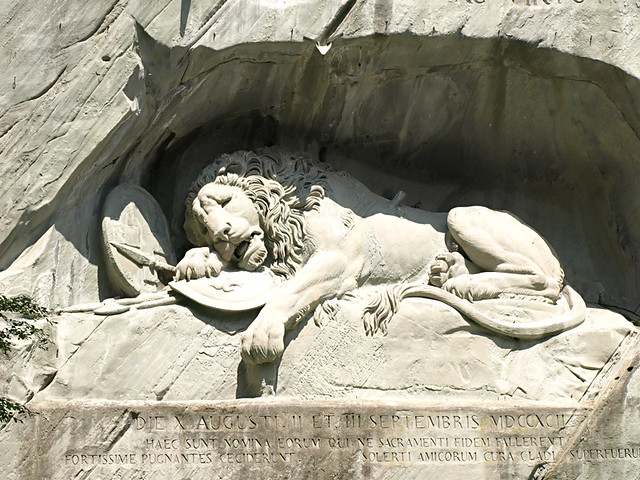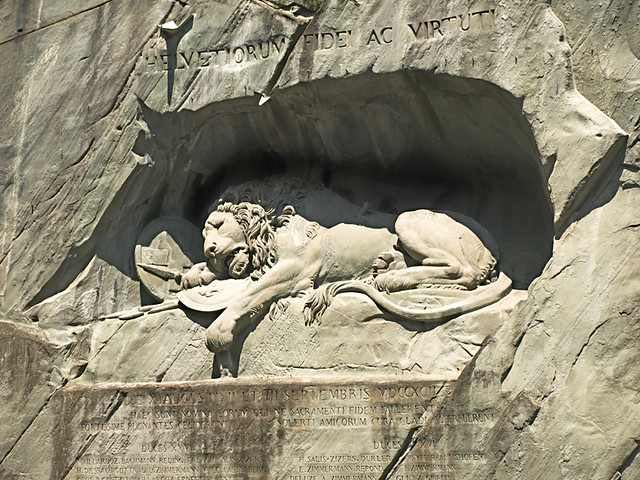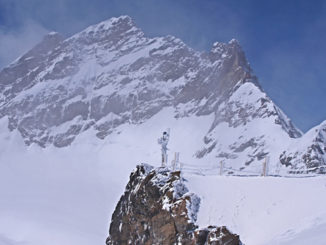In a former quarry in the city of Lucerne, carved into the sandstone face of a cliff, is a dying lion with a broken spear through his heart and his paw draped over a shield bearing the fleur-de-lis emblem of the Bourbon family. Above him, the words ‘Helvetorium Fidei ac Virtuti’ are carved (‘To the Loyalty and Bravery of the Swiss’).
Set behind a body of water, remote from the thousands of eyes that daily watch his suffering, the Lion of Lucerne evokes strong emotions. His powerful limbs lie, as if in slumber; his noble head, framed by its magnificent mane, rests upon his front paw and in his face is hewn the pain and sorrow of defeat as he exhumes his final breath. Alone.
It is the most moving sculpture I have ever laid eyes upon, made all the more emotive by the reason behind its creation. Designed by Danish sculptor Bertel Thorvaldsen and carved by stonemason Lukas Ahorn, the Lion of Lucerne or the Lion Monument as its known, was carved in 1821 as a tribute to a body of men who died or were massacred in the line of duty.
On August 10th 1792 a 30,000 strong crowd of angry insurgents marched towards the Tuileries Palace in Paris where King Louis XVI and Marie Antoinette were being guarded by 950 members of the elite voluntary army of the Swiss Guard. Fearing for their lives, the King and his family fled the Palace through a secret passage and surrendered themselves to the Legislative Assembly, leaving no command for their besieged protectors.
Having received no orders to surrender the Palace, as the mob approached, the Swiss Guard are said to have initially thrown some cartridges from the windows to let the crowd know their intent was peaceful and to have begun to fraternize with the mob. From that point, it’s unclear from where the first shot rang out, but the crowd attacked and the Swiss Guard opened fire, killing around 200 insurgents in the first wave of attack.
A note from King Louis XVI ordering the Swiss Guard to stand down and retire to their barracks has survived to this day, but it arrived too late to stop the course of violence which had begun and by the time the order was given, they had already suffered heavy casualties and were running out of ammunition. Given the order to retreat, the Swiss Guard fled through the palace gardens where, their ranks broken, they were surrounded by the mob and slaughtered.
Of the 950 soldiers at the Tuileries that day, 600 died in battle or were massacred during retreat; around 60 were taken prisoner and escorted to Hotel de Ville but were slaughtered on arrival; 200 more are believed to have died in prison of their wounds and most of the remainder were killed during the September massacres that followed. In all, only 100 are thought to have survived.
The idea to create a commemorative sculpture was taken by Karl Pfyffer von Altishofen, an officer of the Swiss Guard who was on leave in Lucerne when the August 10th massacre took place. He began collecting money for the project and engaged the services of Thorvaldsen to undertake the work. Before the project was completed, Thorvaldsen was told that not enough money had been raised to meet his full fee. Annoyed, but not wanting to disrespect the memory of the soldiers his monument was dedicated to, instead he wrote his disdain in the wall.
If you look at the shape of the alcove in which the lion lies, you will clearly see the outline of a pig.
Andrea (Andy) Montgomery is a freelance travel writer and co-owner of Buzz Trips and The Real Tenerife series of travel websites. Published in The Telegraph, The Independent, Wexas Traveller, Thomas Cook Travel Magazine, EasyJet Traveller Magazine, you can read her latest content on Google+







Powerful story, and well told. Wars always produce these tragic stories. When will be learn, I wonder?